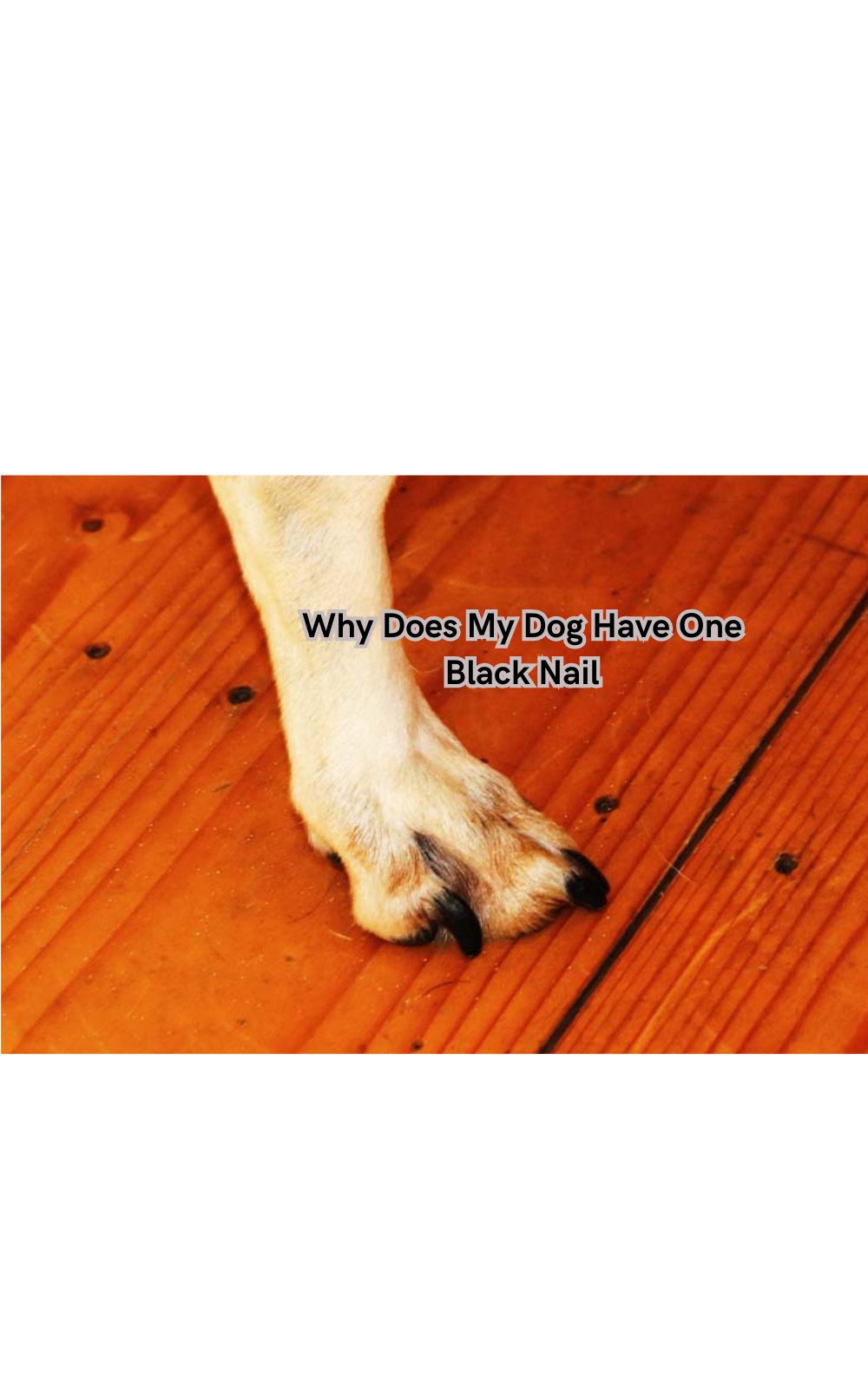Why Does My Dog Have One Black Nail
In this exploration, we'll delve into the fascinating reasons why some dogs have a single black nail, unraveling the biological, genetic, and evolutionary factors.

Have you ever noticed your dog has one black nail among the rest?
This intriguing phenomenon often piques the curiosity of pet owners and enthusiasts alike. Understanding why this occurs can illuminate various aspects of canine anatomy and genetics.
In this exploration, we'll delve into the fascinating reasons why some dogs have a single black nail, unraveling the biological, genetic, and evolutionary factors.
By gaining insight into this unique feature, you can deepen your understanding of your canine companion and embrace the diversity and individuality present in our beloved four-legged friends.
What is Melanonychia in Dogs?
To understand the significance of a single black nail, we must first explore the concept of melanonychia in dogs. Melanonychia refers to an increased amount of pigment (melanin) in a dog's nail, resulting in a darkened appearance. This condition can manifest as a single dark nail or multiple nails with varying degrees of pigmentation.
While some may consider this a cosmetic concern, it is essential to note that melanonychia can also occur as a symptom of an underlying health issue.
Therefore, regular nail maintenance and monitoring can help identify any changes in your dog's nails that may warrant veterinary attention. Brittle nails, nail loss, or changes in nail texture may indicate an underlying problem requiring prompt attention.
White nails may also develop pigmentation due to trauma or chronic infections, so keeping a close eye on your dog's nails for any changes is crucial. Brown nails, on the other hand, may develop due to dietary deficiencies or systemic diseases. Therefore, it is essential to consult with your veterinarian if you notice any unusual changes in your dog's nails.
What Color Should Dog Nails Be?
Dog nails vary in color, depending on their breed, age, and individual characteristics. Generally, dog nails can be clear or white, black or dark brown, or a combination of colors.
Dog's nails consist of a hard outer shell (keratin) and a soft inner core (the quick), which contains blood vessels and nerves. The color of the nail is determined by the level of pigmentation in the quick. Pink nails have less pigmentation, while black nails have more.
Typically, dogs with light-colored fur have lighter nails, while dogs with dark fur have darker nails. However, breed and individual genetics can also affect nail color.
For example, breeds such as the Malamute and Akita often have bi-colored nails, with some being more pigmented than others. Nail discoloration can also occur due to injuries, infections, or underlying health conditions. Therefore, it is essential to monitor any changes in your dog's nail color and consult with a veterinarian if necessary.
Why Does My Dog Have One Black Nail?
Now that we have explored the concept of melanonychia and nail color in dogs let's discuss why some dogs may have one black nail among the rest. Here are some reasons that may explain this unique feature:
Genetics:
Just like humans, dogs can inherit certain physical characteristics from their parents, including the color of their nails. Some breeds are more prone to having a single black nail due to their genetic makeup. For example, many Labrador Retrievers have one or two black nails due to a gene mutation.
In West Highland white terrier breeds, having one black nail is a genetic characteristic that has been passed down through generations. Dark nails in dogs are also more common in certain breeds, such as Schnauzers and Rottweilers.
Trauma & Injury:
Injuries to a dog's nail can also cause changes in its color and pigmentation. If your dog has recently experienced trauma or injury to one of its nails, it may result in a blackened appearance.
The dark color is usually due to bleeding under the nail bed, which will eventually heal with time. Nail bed sometimes grows back lighter in color, resulting in one black nail among the rest.
Pet parents should monitor the affected nail and consult with a veterinarian if there are any concerning changes.
Age:
As dogs age, they may experience changes in their nails, just like humans do. Older dogs may develop pigmented nails as a natural part of the aging process. This is not a cause for concern unless other accompanying symptoms or health issues exist.
Regular grooming and a healthy diet can help keep your dog's nails strong and healthy, regardless of age. Elderly dogs frequently experience nail issues due to their nails becoming more brittle and longer if they're not regularly trimmed, rendering seniors particularly vulnerable to such problems.
Environmental Nail Damage:
Environmental factors, such as excessive exposure to sunlight or harsh chemicals, can also cause changes in a dog's nail color. Sun damage can bleach nails and make them appear lighter in color, while chemical exposure can lead to discoloration.
Repetitive activities such as digging or scratching at surfaces can also wear down the layers of pigment on a dog's nails, resulting in discoloration.
Bacterial Paronychia:
Bacterial paronychia is a common nail infection in dogs that can result in discoloration and inflammation of the nail bed. This condition may cause one or multiple nails to turn black, along with other symptoms such as swelling, discharge, and pain.
If your dog has an underlying health issue that weakens its immune system, it may be more prone to bacterial paronychia. Therefore, regular nail maintenance and eyeing for any changes in your dog's nails can help prevent and catch this infection early on.
Fungal Infections:
Fungal infections can also cause changes in a dog's nail color, with black nails being a common result. This infection can occur due to moisture or other underlying health issues that weaken the immune system.
If you suspect your dog has a fungal infection, seeking veterinary attention for proper diagnosis and treatment is crucial.
Symmetrical Lupoid Onychodystrophy (SLO) :
Symmetrical Lupoid Onychodystrophy (SLO) is an autoimmune disease that affects a dog's nails, causing them to turn black and eventually fall off. This condition can be painful for dogs and may also cause other symptoms such as lameness, loss of appetite, and lethargy.
If you notice changes in your dog's nail color accompanied by these symptoms, it is essential to consult with a veterinarian immediately.
Dog's nails are regularly growing and constantly in use; it is crucial to keep an eye on any changes that may indicate underlying health issues. By understanding the reasons behind your dog's nail color, you can provide proper care and ensure their paws are healthy and happy.
Preventing & Maintaining Healthy Nails:
Regular grooming and trimming are essential to maintaining healthy nails. Pay attention to any changes in color or appearance that may indicate underlying issues.
Additionally, keeping your dog's paws clean and dry can help prevent infections and diseases that may affect their nails. Here are some tips for maintaining healthy nails in your dog:
- Preventing nail injury: Be mindful of your dog's activities and surroundings to prevent injuries that may affect their nails. Nail health can also be maintained by regularly trimming your dog's nails so they're not too long or prone to breaking.
- Regular grooming: Trim your dog's nails regularly, depending on their breed and activity level. Overgrown nails can cause discomfort and hinder proper movement.
- Healthy diet: A balanced and nutritious diet can help promote healthy nail growth in dogs.
- Consult with a veterinarian: If you notice dog nails becoming dark, consult with a veterinarian to rule out any underlying health issues and receive proper treatment if necessary.
- Protect paws from harsh chemicals: If your dog is exposed to harsh chemicals or surfaces, protect its paws by using protective boots or avoiding these areas altogether.
- Maintain paw hygiene: Keeping your dog's paws clean and dry can help prevent infections and diseases that may affect their nails. After walks or outdoor play, be sure to clean your dog's paws and check for any signs of injury or infection.
By following these tips and monitoring your dog's nails regularly, you can help prevent nail problems and maintain healthy nails in your furry friend. Remember, a healthy paw means a happy pup.
What is Nail Bed Cancer?
While changes in a dog's nail color may be due to various reasons, it is essential to watch out for any signs of nail bed cancer. Nail bed tumors are relatively uncommon in dogs but can occur as benign or malignant growths under the toenail or fingernail.
Symptoms of nail bed cancer may include:
- Changes in nail color
- Swelling and inflammation around the nail
- Bleeding or discharge from under the nail
- Difficulty walking or limping
If you notice any of these symptoms, it is crucial to consult with a veterinarian for proper diagnosis and treatment. Early detection and treatment can greatly increase the chances of successful management of nail bed cancer in dogs.
FAQs
Do dogs nails change color?
Yes, a dog's nails can change color due to various reasons, such as aging, environmental factors, infections, and diseases. Plus, certain breeds may have naturally darker or lighter-colored nails.
Are black nails normal in dogs?
Yes, black nails are common in dogs of certain breeds and ages. However, any sudden changes or signs of discomfort should be examined by a veterinarian.
What deficiency causes black toenails?
A deficiency in essential nutrients, such as biotin or zinc can cause black toenails in dogs. It is crucial to provide your dog a balanced and nutritious diet to prevent deficiencies that may affect their nail health. If you suspect a nutrient deficiency, consult a veterinarian for proper diagnosis and treatment.
Why does my dog have some black nails and some white?
The color of a dog's nails can vary depending on their breed, age, and individual pigmentation. Some dogs may have a mix of black and white nails, which is considered normal. However, suppose you notice sudden changes in the color of your dog's nails or any other concerning symptoms. In that case, it is important to consult with a veterinarian for proper diagnosis and treatment.
Conclusion
In conclusion, one black nail in dogs encompasses a spectrum of natural variation, genetic factors, and potential health considerations. While it's often a benign feature influenced by melanin pigmentation and breed-specific traits, pet owners should remain attentive to any changes in nail color or signs of infection.
By understanding the multifaceted reasons behind this occurrence, you can appreciate the individuality of your canine companion and proactively address any concerns related to nail health. Regular inspection of your dog's nails, coupled with prompt veterinary attention if abnormalities arise, ensures your furry friend's overall well-being and comfort.
Embracing the diversity in nail coloration among dogs enriches the bond between pet owners and their beloved companions, fostering a deeper appreciation for the unique attributes that make each dog special.
